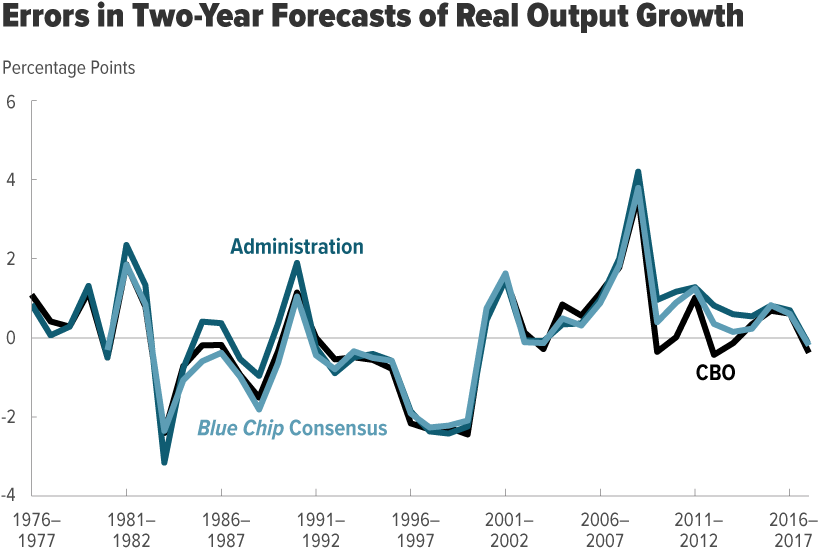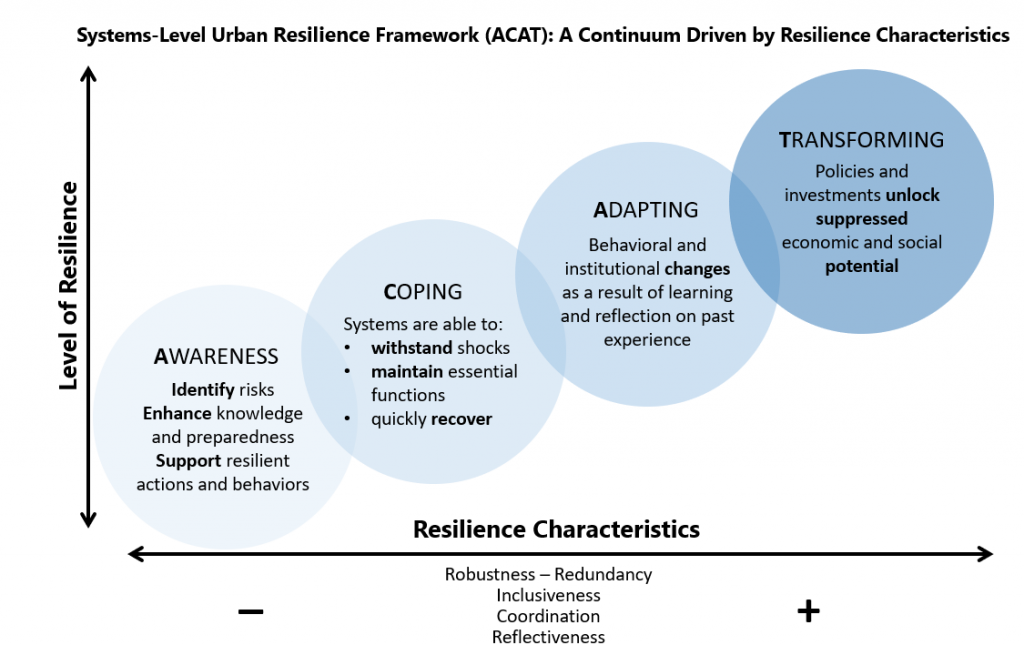“This evaluation examines the World Bank Group’s evolving experience in building resilience in urban areas during the period 2007–17. The focus of this evaluation is the World Bank Group’s support to clients in building urban resilience—to cope, recover, adapt and transform—in the face of shocks and chronic stresses.
Thursday, October 31, 2019
CBO’s Economic Forecasting Record: 2019 Update
From Congressional Budget Office:
“CBO’s economic forecasts have been comparable in quality to those of the Administration and the Blue Chip consensus. Large errors in CBO’s forecasts tend to reflect challenges faced by all forecasters.
Each year, CBO prepares economic forecasts that underlie its projections of the federal budget. CBO forecasts hundreds of economic variables, but some—including output growth, the unemployment rate, inflation, interest rates, and wages and salaries—play a particularly significant role in the agency’s budget projections. To evaluate the quality of its economic projections, estimate uncertainty ranges, and isolate the effect of economic errors on budgetary projections, CBO regularly analyzes its historical forecast errors. That analysis serves as a tool for assessing the usefulness of the agency’s projections.
In this report, CBO evaluates its two-year and five-year economic forecasts from as early as 1976 and compares them with analogous forecasts from the Administration and the Blue Chip consensus—an average of about 50 private-sector forecasts published in Blue Chip Economic Indicators. External comparisons help identify areas in which the agency has tended to make larger errors than other analysts. They also indicate the extent to which imperfect information may have caused all forecasters to miss patterns or turning points in the economy.”
Continue reading here.
From Congressional Budget Office:
“CBO’s economic forecasts have been comparable in quality to those of the Administration and the Blue Chip consensus. Large errors in CBO’s forecasts tend to reflect challenges faced by all forecasters.
Each year, CBO prepares economic forecasts that underlie its projections of the federal budget. CBO forecasts hundreds of economic variables, but some—including output growth,
Posted by at 11:15 AM
Labels: Forecasting Forum
Building Urban Resilience: An Evaluation of the World Bank Group’s Evolving Experience (2007-2017)
From the World Bank:
From the World Bank:
“This evaluation examines the World Bank Group’s evolving experience in building resilience in urban areas during the period 2007–17. The focus of this evaluation is the World Bank Group’s support to clients in building urban resilience—to cope, recover, adapt and transform—in the face of shocks and chronic stresses.
The Urban Resilience Challenge
Most urban growth is taking place in developing countries and emerging economies in an informal and unmanaged way.
Posted by at 11:13 AM
Labels: Global Housing Watch
Tuesday, October 29, 2019
Geography of desperation in America
A Brookings piece based on a new paper by Carol Graham and Sergio Pinto:
“There is much to be troubled about in the state of America today. We boast booming stock markets and record low levels of unemployment, yet significant sectors of our society are dying prematurely from preventable deaths (deaths of despair) and almost 20% of prime aged males are out of the labor force.1 Americans have higher levels of well-being inequality and report more pain on average than countries of comparable and even lower levels of income. There are other signs of decline, ranging from falling levels of civic trust to viscerally divided politics.
These trends have already received significant scholarly attention. Yet we provide a different perspective by tracking the reported well-being and ill-being of individuals and places. We find large differences in these trends across education levels, races, and places. Desperation – and the associated trends in premature mortality – are concentrated among the less than college educated and are much higher among poor whites than poor minorities, who remain optimistic about their futures. The trends are also geographically dispersed, with racially and economically diverse urban and coastal places much more optimistic and with much lower incidences of premature mortality (on average). Both death and desperation are higher in the heartland and in particular in areas that were previously hubs for the manufacturing and mining jobs which have long since disappeared.
Our earlier work shows that the geographic patterns in lack of hope, worry, reported pain, reliance on disability insurance, and deaths of despair are remarkably consistent across these places. Monnat and Brown (2017) find that counties with higher levels of poverty, obesity, deaths due to drugs, alcohol, and suicide, more non-Hispanic whites, individuals on disability or other safety nets, and smokers were the same places where Trump “over-performed” in terms of predicted votes 2016.3
In this paper, we supplement what we know about these race and place-based trends with new research on the role of inter-generational mobility, prime aged individuals out in the labor force, and rural and micropolitan versus urban differences. We explore how patterns across these cohorts, races, and places associate with the worrisome trends in lack of hope and premature death. We also add in new indicators which assess financial, social, purpose, and community level well-being”
A Brookings piece based on a new paper by Carol Graham and Sergio Pinto:
“There is much to be troubled about in the state of America today. We boast booming stock markets and record low levels of unemployment, yet significant sectors of our society are dying prematurely from preventable deaths (deaths of despair) and almost 20% of prime aged males are out of the labor force.1 Americans have higher levels of well-being inequality and report more pain on average than countries of comparable and even lower levels of income.
Posted by at 12:12 PM
Labels: Inclusive Growth
Monday, October 28, 2019
Trade effects of 3D printing (that you didn’t hear about)
From VOX post by Caroline Freund, Alen Mulabdic, and Michele Ruta:
“The conventional wisdom is that 3D printing will shorten supply chains and reduce world trade. This column examines the trade effects of the shift to 3D printing in the production of hearing aids. It shows that adopting the new technology in production increased trade by roughly 60% as production costs came down. An analysis of 35 other products that are increasingly produced using 3D printing also finds positive effects but suggests that product characteristics such as bulkiness can affect the relationship between 3D printing and trade.
Will 3D printing disrupt world trade? The new technology has been accompanied by predictions of a future where goods will be printed locally, global supply chains will be shortened, and international trade will be dramatically reduced. Firms (and perhaps even consumers) will be able to create a solid three-dimensional object from a digital file and will no longer need to import printable goods and components. One study calculates that as much as 40% of trade could be eliminated by 2040 (Leering 2017). Other studies acknowledge that the impact of 3D printing on trade may be complex but still find that 3D printing and automation could lower world trade by 10% by 2030 (Lund and Bughin 2019).
In contrast, many earlier improvements in production processes that have reduced real costs have boosted international trade. The industrial revolution is perhaps the best example, where a transformation in technology and management practices brought huge productivity gains, output growth, and expanding trade. The digital revolution of the 1990s had a similar boosting effect on world trade through the rise of global supply chains (Baldwin 2016). The impact of 3D-printing technology on world trade is, therefore, an empirical question.
We address this question in a new paper (Freund et al. 2019), focusing on hearing aids, a product that since the mid-2000s has almost exclusively been produced with 3D printing. We then extend the analysis to 35 other products that are increasingly using 3D printing. The evidence suggests that firms (and countries) will continue to specialise and 3D printing will stimulate rather than hamper trade growth.
The 3D printing revolution in hearing aids
The good where 3D printing is most prevalent is hearing aids. Nearly 100% of all hearing aids consumed in the world are produced using 3D printing. 3D printers transformed the hearing aid industry in less than 500 days in the mid-2000s, which makes it a unique natural experiment to assess the trade effects of this technology (Figure 1).”
Figure 1 Adoption of 3D printing for custom hearing aids at Phonak
Source: Brans (2013)
Continue reading here.
From VOX post by Caroline Freund, Alen Mulabdic, and Michele Ruta:
“The conventional wisdom is that 3D printing will shorten supply chains and reduce world trade. This column examines the trade effects of the shift to 3D printing in the production of hearing aids. It shows that adopting the new technology in production increased trade by roughly 60% as production costs came down. An analysis of 35 other products that are increasingly produced using 3D printing also finds positive effects but suggests that product characteristics such as bulkiness can affect the relationship between 3D printing and trade.
Posted by at 10:59 AM
Labels: Inclusive Growth
Friday, October 25, 2019
Housing View – October 25, 2019
On cross-country:
- Part Two: How will we live in the 2020s? – Financial Times
- News-driven housing booms: Spain vs. Germany – EconPapers
On the US:
- Housing: It’s About More Than Money – NPR
- Untangling the Housing Shortage and Gentrification – Citylab
- Remodeling Market Expected to Stall in 2020 – Harvard Joint Center for Housing Studies
- Economists identify an unseen force holding back affordable housing – Seattle Times
- The missing housing boom – Axios
- The Mortgage Prepayment Decision: Are There Other Motivations Beyond Refinance and Move? – Federal Reserve Bank of Philadelphia
- Let’s get housing reform right this time – American Banker
- Is it time for American cities to stop growing? – VOX
- Will the housing market continue to prop up the US economy? – CNN
- Why Tax Changes Are Hurting the Housing Market – University of Pennsylvania
- Does Oregon Have the Answer to High Housing Costs? – Wall Street Journal
On other countries:
- [Hong Kong] Concerns raised Hong Kong’s housing reforms could overheat market – Financial Times
- [Hong Kong] Hong Kong Residential Market Survey – RICS-SPACIOUS
- [Portugal] Porto property prices rise at rapid rate – Financial Times
- [United Kingdom] Britain’s housing paradox: overcrowding and underoccupancy are both rising – The Economist
On cross-country:
- Part Two: How will we live in the 2020s? – Financial Times
- News-driven housing booms: Spain vs. Germany – EconPapers
On the US:
- Housing: It’s About More Than Money – NPR
- Untangling the Housing Shortage and Gentrification – Citylab
- Remodeling Market Expected to Stall in 2020 – Harvard Joint Center for Housing Studies
- Economists identify an unseen force holding back affordable housing – Seattle Times
- The missing housing boom – Axios
- The Mortgage Prepayment Decision: Are There Other Motivations Beyond Refinance and Move?
Posted by at 5:00 AM
Labels: Global Housing Watch
Subscribe to: Posts






